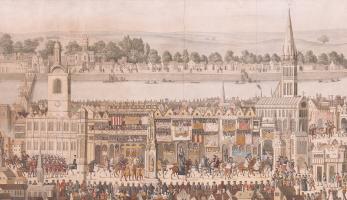Text this colour links to Pages. Text this colour links to Family Trees. Place the mouse over images to see a larger image. Click on paintings to see the painter's Biography Page. Mouse over links for a preview. Move the mouse off the painting or link to close the popup.
Archaeologia Volume 8 Section XXXVII is in Archaeologia Volume 8.

An historical and descriptive account of the Ancient Painting preserved at Cowdray in Sussex, the Seat of Lord Viscount Montague: representing the Procession of King Edward VI. from the Tower of London to Westminster, February 19th, A.D. 1547, previous to his Coronation. By John Topham, Esq. F.R.A.S. Read April 19, 1787.

The drawing now exhibited is made from one of those curious historical paintings which have been long since introduced to the notice of this Society by our late learned Vice President Sir Joseph Ayloffe, Baronet, in an account of some ancient historical paintings at Cowdray in Sussex, published in the Transacions of this Society, Archaeologia, vol. III. p. 239 — 2J2. In that memoir may be seen a minute description of many of those valuable representations which preserve several interesting parts of our national events, and exhibit to our view the state of the arts, and the dresses, manners, and usages, which prevailed amongst our ancestors about the middle of the sixteenth century.
The painting which is now the object of our attention fills one of the compartments on the right-hand side of the great dining-room in that noble mansion; and contains the procession of king Edward VI. from the Tower of London to Westminster, the day preceding that of his coronation.
At the decease of king Henry VIII., Edward his son and successor was but nine years and three months old. The young monarch was then at Hertford, together with the princess Elizabeth his sister; and Edward Seymour, earl of Hertford, and Sir Anthony Brown, were deputed by the council to inform their new sovereign of the death of his father, and to conduct him to the Tower of London; where, upon his arrival, he was proclaimed king, on the 31st of January, A.D. 1.546-7.